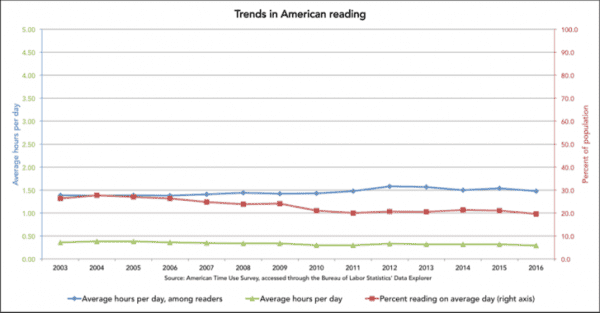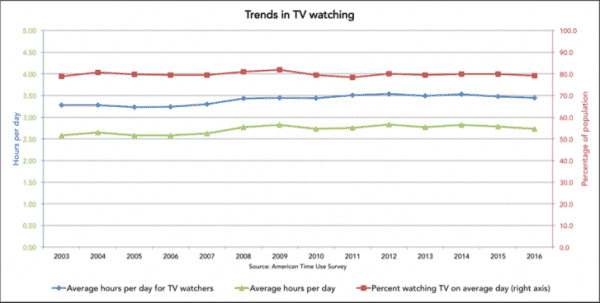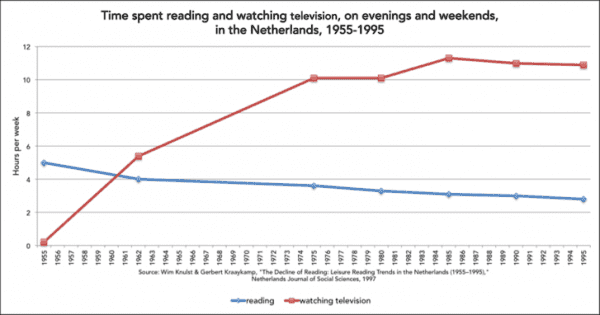
A little more than a decade ago, I wrote an article for The New Yorker about American reading habits, which a number of studies then indicated might be in decline. I was worried about what a shift to “secondary orality”—a sociological term for a post-literate culture—might do to America’s politics. “In a culture of secondary orality, we may be less likely to spend time with ideas we disagree with,” I wrote. I suspected that people might become less inclined to do fact checking on their own; “forced to choose between conflicting stories,” they would “fall back on hunches.”
I’ll go out on a limb and say that I don’t think that I got this part wrong. But I’ve often wondered whether I was right about the underlying trend, too. Were Americans in fact reading less back then? And are they reading even less today? Whenever I happen across a news article on the topic, I wonder if I’m about to find out whether I was Cassandra or Chicken Little.
In assessing reports about reading habits, I keep in mind a couple of lessons from the research that I did a decade ago. First, although American adults seem to get a kick out of worrying about whether American children are reading enough, this is an enormous waste of time in the world in which we happen to live. Children who have any hope of getting into or remaining in the middle class are under great social and economic pressure to excel at academics, and, of all Americans, they are perhaps the least likely to change their reading habits of their own volition. Even the amount of pleasure reading they do seems likely to reflect the social pressure they’re under—not where America in general is headed.
Second, in studies of reading habits, the gold standard is asking participants to report hour by hour how they spent a particular day. It’s pretty much useless to ask how many books somebody read last year, because almost nobody remembers, and many exaggerate, to seem smarter. At the time I wrote my article, the best American data came from a time-use study begun by the U.S. Department of Labor in 2003, statistics that were then still only a few years old, and inconclusive.
In January, however, a Times article about American sleep habits alerted me to the fact that the Department of Labor’s American Time Use Survey is alive, well, and all grownup now. It now has fourteen years of data, series upon series of which is easily accessible through its home page, and also through a Labor Department data portal. Another look at American reading habits seemed timely.
I’ll cut to the chase: between 2003 and 2016, the amount of time that the average American devoted to reading for personal interest on a daily basis dropped from 0.36 hours to 0.29 hours. It would seem that reading in America has declined even further in the past decade. But statistics can be tricky, so let’s kick the tires a little.
One hazard of statistics is the contribution of “compositional effects.” Suppose a survey finds that the average American today eats a third fewer French fries than he did a decade ago. Oddly, this wouldn’t necessarily mean that any Americans have changed their French-fry-eating habits. It might be, instead, that the “composition” of the American population has changed. Maybe there are fewer men and more women in America than there used to be, and maybe men tend to eat more French fries. In that case, the average French-fry consumption would drop even if the typical man and the typical woman continued eating a number of French fries no different from the number they had eaten from time immemorial.
It’s possible that a compositional effect explains the decline of reading in America. Maybe, for example, as more women have entered the workforce, their full-time employment has left them with less leisure to read. It’s easy to check such a hypothesis by parsing the data from the American Time Use Survey according to gender. Women read more than men, it turns out, but time spent reading has declined steadily for both genders. If you break down the data according to employment status, meanwhile, you see that the unemployed do read more, but they, part-timers, and full-timers all read steadily less as the decade went forward. The same applies when you break down the data by race and ethnicity or by age; you see differences in the amount of reading, but a decline is taking place in almost every subgroup.
A less explored cause might be the recession. America’s middle class is shrinking, and the proportion of Americans in the labor force is lower than it has been since the nineteen-seventies. Maybe people read less when they have less money? From a breakdown of reading by income quartile, it turns out that the rich read more—but they read less and less every year. Americans in the lowest income quartile did manage to read more in 2016 than they did in 2003—a rare trend—but that’s probably a dead-cat bounce; the 2003 number was so low that it was as likely to improve as not. All these factors are probably making some contribution to a compositional effect. But nothing, to my eye, looks substantial enough to explain away the over-all trend: Americans are reading less.
To make sense of the data from the American Time Use Survey, it helps to know how they’re collected. A pamphlet explaining the survey is mailed to each subject ahead of the day to be observed. The day after, a survey-taker telephones to ask how the subject spent her time. A subject who doesn’t report any reading may not be a non-reader in any absolute sense. All we know for sure is that she didn’t happen to do any reading on the day under scrutiny.
As a statistic, therefore, the number of average hours spent reading is perhaps less telling than two other statistics: the percentage of the population that did some reading, and the average time that these readers spent on their reading.

Here there’s a little bit of good news: the average American reader spent 1.39 hours reading in 2003, rising to 1.48 hours in 2016. That’s the very gradually rising blue line in the graph above. In other words, the average reading time of all Americans declined not because readers read less but because fewer people were reading at all, a proportion falling from 26.3 per cent of the population in 2003 to 19.5 per cent in 2016. You could call this a compositional effect, but it’s a rather tautological one: reading is in decline because the population is now composed of fewer readers. And the assessment would be a little unfair: we don’t know that the survey’s non-readers are in fact never-readers. All we know is that, when Americans sit down to read, they still typically read for about an hour and a half, but fewer are doing so, or are doing so less often.
It’s beyond my statistical powers (though probably not beyond an expert’s) to figure out whether a decline in an individual’s reading tends to be correlated with a rise in any other activity measured by the American Time Use Survey. I can only offer suggestive comparisons. The activity that the survey calls “socializing and communicating” seems to be shifting in more or less the same way that reading is: those who take part spend about as much time on it as they ever did, but the over-all average of hours per day spent on it is declining because fewer people are taking part.
Perhaps whatever is eating away at reading is also eating away at socializing. More and more people are taking part in “game playing” and “computer use for leisure, excluding games,” even as the time that devotees spend on the activities holds steady. It’s possible, too, that the numbers may be reflecting a shift in the way that people read news and essays. As best as I can tell from the survey’s coding instructions, reading an e-book and listening to an audiobook both count as “reading.” With computer activity, which would seem to include the use of smartphones, the survey-taker is supposed to “code the activity the respondent did as the primary activity,” which presumably means that reading a newspaper or magazine online would also be classified as “reading.” But “browsing on the internet” is listed in the survey’s official lexicon as an example of “computer use for leisure, excluding games.” So there’s a chance that people who used to read the newspaper in print and be counted as “reading” are now doing so online and being counted as Web surfers.
But, at last, we come to the rival to reading known as television, and find a footprint worthy of a Sasquatch.

Television, rather than the Internet, likely remains the primary force distracting Americans from books. The proportion of the American population that watches TV must have hit a ceiling some time ago; in the years studied by the American Time Use Survey, it’s very stable, at a plateau of about eighty per cent—roughly four times greater than the proportion of Americans who read. But America’s average TV time is still rising, because TV watchers are, incredibly, watching more and more of it, the quantity rising from 3.28 hours in 2003 to 3.45 hours in 2016.
When I was researching my article ten years ago, the sturdiest and most convincing data about reading habits that I found came from a Dutch time-use study, which went back decades. It showed with remorseless detail how television had dethroned reading in the Netherlands between 1955 and 1995. (The data aren’t directly comparable, because the Dutch recorded not hours per day but hours per week, limiting their observations to evenings and weekends.)

These are remarkable curves. I think it’s fair to imagine the trends captured by the American Time Use Survey as an extension rightward, into the twenty-first century, of the lines in the Dutch graph. More than half a century after television’s début, its share of American leisure time is still growing—and reading’s share is still falling. The Dutch researchers Wim Knulst and Gerbert Kraaykamp observed that each generation seems more susceptible to television’s wiles than the generation before it. That observation is confirmed by the American Time Use Survey, which shows that older Americans are more likely to have sat down with a book the day before the survey-taker called.
In the end, the data from the American Time Use Survey paint a fairly grim picture of America’s reading habits. They don’t completely relieve me of my fear of being Chicken Little; it’s possible that the migration of news from print to the digital realm has disguised some reading as mere computer leisure. I suspect, though, that the fraction of such computer use devoted to essays and news is too small to provide much mitigation. The long march to secondary orality seems well under way. The nation, after all, is now led by a man who doesn’t read.
Sourse: newyorker.com






